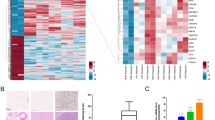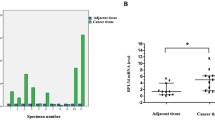Abstract
Osteosarcoma is the most common type of bone cancer. In the present study, by way of PCR-based microarrays, we found that TUT1, a nucleotidyl transferase, was significantly downregulated in osteosarcoma, compared with adjacent normal tissues. In the current study, we performed PCR-based microarrays using the cDNA prepared from osteosarcoma and adjacent normal tissues. The enforced expression of TUT1 was able to inhibit cell proliferation in U2OS and MG63 cells, while its knockdown using small interfering RNA (siRNA) oligos promoted cell proliferation. At the molecular level, we found that TUT1 could inhibit the expression levels of PPARgamma and SREBP-1c, two key regulators in lipogenesis, through upregulation of microRNA-24 and microRNA-29a. Therefore, our results suggest that TUT1 may act as a tumor suppressor for osteosarcoma, which might provide a novel mechanism for the tumor development.






Similar content being viewed by others
References
Luetke A, Meyers PA, Lewis I, Juergens H. Osteosarcoma treatment—where do we stand? A state of the art review. Cancer Treat Rev. 2014;40:523–32.
Botter SM, Neri D, Fuchs B. Recent advances in osteosarcoma. Curr Opin Pharmacol. 2014;16C:15–23.
Sun K, Lai EC. Adult-specific functions of animal microRNAs. Nat Rev Genet. 2013;14:535–48.
Ameres SL, Zamore PD. Diversifying microRNA sequence and function. Nat Rev Mol Cell Biol. 2013;14:475–88.
Tessitore A, Cicciarelli G, Del VF, Gaggiano A, Verzella D, Fischietti M, et al. MicroRNAs in the DNA damage/repair network and cancer. Int J Genomics. 2014;2014:820248.
Miao J, Wu S, Peng Z, Tania M, Zhang C. MicroRNAs in osteosarcoma: diagnostic and therapeutic aspects. Tumour Biol. 2013;34:2093–8.
Yang J, Zhang W. New molecular insights into osteosarcoma targeted therapy. Curr Opin Oncol. 2013;25:398–406.
Zhou G, Shi X, Zhang J, Wu S, Zhao J. MicroRNAs in osteosarcoma: from biological players to clinical contributors, a review. J Int Med Res. 2013;41:1–12.
Song QC, Shi ZB, Zhang YT, Ji L, Wang KZ, Duan DP, et al. Downregulation of microRNA-26a is associated with metastatic potential and the poor prognosis of osteosarcoma patients. Oncol Rep. 2014;31:1263–70.
Cai H, Lin L, Cai H, Tang M, Wang Z. Combined microRNA-340 and ROCK1 mRNA profiling predicts tumor progression and prognosis in pediatric osteosarcoma. Int J Mol Sci. 2014;15:560–73.
Knouf EC, Wyman SK, Tewari M. The human TUT1 nucleotidyl transferase as a global regulator of microRNA abundance. PLoS One. 2013;8:e69630.
Dweep H, Sticht C, Gretz N. In-silico algorithms for the screening of possible microRNA binding sites and their interactions. Curr Genomics. 2013;14:127–36.
Israel M, Schwartz L. The metabolic advantage of tumor cells. Mol Cancer. 2011;10:70.
Rochefort H, Chalbos D. The role of sex steroid receptors on lipogenesis in breast and prostate carcinogenesis: a viewpoint. Horm Cancer. 2010;1:63–70.
Zaidi N, Lupien L, Kuemmerle NB, Kinlaw WB, Swinnen JV, Smans K. Lipogenesis and lipolysis: the pathways exploited by the cancer cells to acquire fatty acids. Prog Lipid Res. 2013;52:585–9.
Lin R, Tao R, Gao X, Li T, Zhou X, Guan KL, et al. Acetylation stabilizes ATP-citrate lyase to promote lipid biosynthesis and tumor growth. Mol Cell. 2013;51:506–18.
Jeon SM, Chandel NS, Hay N. AMPK regulates NADPH homeostasis to promote tumour cell survival during energy stress. Nature. 2012;485:661–5.
Li J, Dong L, Wei D, Wang X, Zhang S, Li H. Fatty acid synthase mediates the epithelial-mesenchymal transition of breast cancer cells. Int J Biol Sci. 2014;10:171–80.
Mao JH, Zhou RP, Peng AF, Liu ZL, Huang SH, Long XH, et al. MicroRNA-195 suppresses osteosarcoma cell invasion and migration in vitro by targeting FASN. Oncol Lett. 2012;4:1125–9.
Long XH, Mao JH, Peng AF, Zhou Y, Huang SH, Liu ZL. Tumor suppressive microRNA-424 inhibits osteosarcoma cell migration and invasion via targeting fatty acid synthase. Exp Ther Med. 2013;5:1048–52.
Cheng C, Chen ZQ, Shi XT. MicroRNA-320 inhibits osteosarcoma cells proliferation by directly targeting fatty acid synthase. Tumour Biol. 2014 Jan 5.
Conflicts of interest
None
Author information
Authors and Affiliations
Corresponding authors
Additional information
De-qiu Zhu and Yue-fen Lou contributed equally to this work.
Electronic supplementary material
Below is the link to the electronic supplementary material.
Supplementary Fig. 1
(DOC 231 kb)
Supplementary Fig. 2
(DOC 218 kb)
Supplementary Fig. 3
(DOC 110 kb)
Supplementary Fig. 4
(DOC 123 kb)
Rights and permissions
About this article
Cite this article
Zhu, Dq., Lou, Yf., He, Zg. et al. Nucleotidyl transferase TUT1 inhibits lipogenesis in osteosarcoma cells through regulation of microRNA-24 and microRNA-29a. Tumor Biol. 35, 11829–11835 (2014). https://doi.org/10.1007/s13277-014-2395-x
Received:
Accepted:
Published:
Issue Date:
DOI: https://doi.org/10.1007/s13277-014-2395-x




